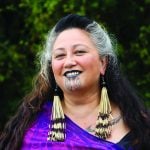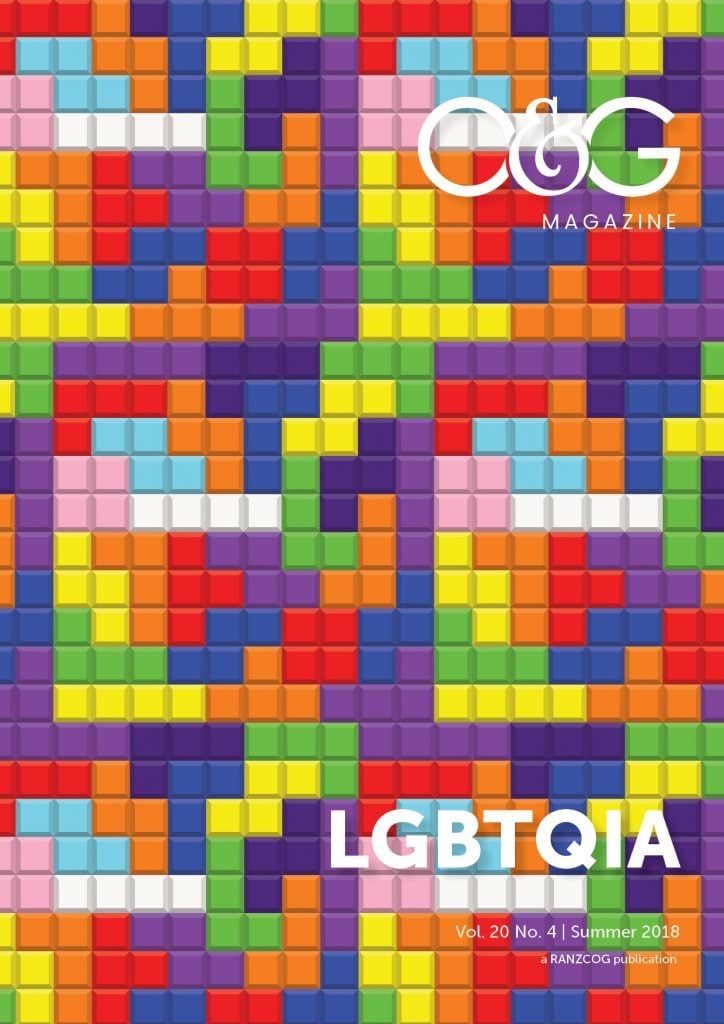Takatāpui is an ancient Māori term from the traditions of the Indigenous people of Aotearoa New Zealand. It means ‘intimate companion of the same sex’. Since the early 1980s, this term has been embraced as an identity by Māori with diverse gender identities, sexualities and sex characteristics, including whakawahine, tangata ira tane,1 lesbian, gay, bisexual, trans, intersex and queer. Takatāpui emphasises Māori cultural and spiritual identity as equal to, or more important than, gender identity, sexuality or having diverse sex characteristics.2
A lack of population data on gender identity or sexual orientation limits the resources and funding necessary to identify and address those issues specific to takatāpui and, even more specifically, to takatāpui who identify as women. In its absence, we are collecting our own data and extrapolating from those findings.3 The term ‘woman’ in relation to takatāpui identity is wonderfully complex. An inclusive definition would denote all woman-identified takatāpui who may be cis-gendered (assigned female at birth), trans, trans feminine or intersex. Others who were assigned female at birth may identify as trans men, gender diverse or intersex. For this purpose, I will use the term ‘female-bodied’ to denote people who would require health services related to obstetrics and gynaecology. These people could be cisgendered women, trans men, intersex or gender diverse people.
Te Whare Tapa Whā health model
As takatāpui is a Māori identity, I use the holistic Te Whare Tapa Whā health model.4 It identifies four interlocking taha (sides or dimensions) to the whare (meeting house) of Māori health and wellbeing: taha wairua, taha hinengaro, taha tinana and taha whānau.
Taha wairua
Wairua refers to the spiritual dimension; the relationship with deities or higher beings, ancestors and the land; our interconnectedness with all things in the universe. For those who are woman-identified and female-bodied, it infers a direct relationship with Papatūānuku, our Mother Earth.
Our conviction of who we are comes from wairua; that drive to identify and find expression for our true selves regardless of the gender we were assigned at birth. It is wairua that drives us to make changes to our physical selves to align with our spiritual awareness. I believe that trans, intersex and the gender diverse are modern day versions of tipua; spiritual and magical creatures who could change gender and form. However, the binary world in which we live reserves particular prejudice for those who dare to subvert its arbitrary boundaries. The wellbeing of takatāpui is severely compromised when their wairua is trampled on through discrimination, rejection and institutionalised heterosexism.
Taha hinengaro
Taha hinengaro refers to the psychological dimension; emotional and mental health. Māori already suffer from the historical trauma and institutionalised racism brought to us by colonisation. Discrimination against takatāpui because of their sexual orientation, gender identity or expression, or sex characteristics, as well as the associated stigma, isolation and secrecy, are likely to cause chronic stress.5
Discrimination, isolation and fear of rejection from whānau (family) takes a toll on the mental health of takatāpui, but especially on those who are young. Same and both-sex attracted young people are four times more likely to experience significant depressive symptoms and five times more likely to have attempted suicide in the previous 12 months.6 Trans young people are four times more likely (41 per cent) to experience significant depressive symptoms and five times more likely to have attempted suicide in the previous 12 months.7
Rainbow communities struggle to access mental health and addiction services. Where services are available, in some cases, they are unhelpful or unsafe, due to inadequate staff training, inappropriate policy settings, exclusionary environments or lack of appropriate referral pathways.8
Taha tinana
Taha tinana refers to the physical dimension; the body itself. Takatāpui share the common Māori experience of growing up variously with violence, sexual abuse, neglect and alcoholism. They are also likely to suffer bullying and violence in other parts of their life because of their diverse genders, sexualities or sex characteristics. That increases the likelihood of the harmful use of alcohol and drugs, or physical and sexual violence.9
Trans, intersex and gender diverse people face significant barriers in accessing gender-affirming healthcare, which may include counselling, hormone therapy or surgery.10 Transphobic discrimination routinely reduces people to their genitalia. In an already intimate and vulnerable situation, there may be additional discomfort because their physical self does not align with their own identity, or match the health practitioner’s expectations.
The assault on the bodily integrity of many intersex people starts at birth and some intersex variations may not become apparent until a person is trying to conceive. Ethical, medical and human rights concerns have been raised11 about medical and surgical practices on intersex infants and children, when they are too young to provide informed consent. The need to repeal these so-called ‘genital normalising’ practices is urgent. The work of the Intersex Roundtable has led to establishing a national intersex clinical network through the Paediatric Society of New Zealand. This world-first network will collect accurate population data and produce medical guidelines for ensuring the bodily integrity of intersex children.
Intersex adults tackle comparable barriers to those who are trans or gender diverse when trying to access general medical care or surgical support. Activists and largely unfunded non-governmental organisations continue to provide guidelines, support and advice to agencies.
Being Māori, takatāpui who are female-bodied share higher rates of cervical cancer. In a 2012 study, Māori females had a registration rate twice that of non-Māori females (RR 2.06, CI 1.64–2.58), and the mortality rate for Māori females was about 2.5 times that of non-Māori females (RR 2.57, CI 1.70–3.90).12 Recent studies have also shown that gynaecological recommendations often do not include clinical considerations specific to trans patients. This increases risk of HPV and other sexually transmitted infections, creates barriers to care and limits recommendations for cervical cancer screening and other appropriate sexual and reproductive health services.13
Taha whānau
Taha whānau refers to the family dimension. Ideally, the family home is where children grow up safe and loved, learn a sense of belonging and gain skills in building connections and relationships. Where dysfunction, strained relationships and abuse already exists, anything that threatens the ‘normality’ of home life could be traumatic, as in the case of someone identifying as takatāpui.14
As we grow older, we have more options for creating our own whānau and support. Not so for our young people. The fear of rejection is daunting, so it often takes a while for takatāpui youth to raise the courage to tell their whānau. They may experience guilt, embarrassment, isolation, fear, depression, anger and hopelessness. When takatāpui youth disclose their diverse sexuality or wish to transition from the gender they were assigned at birth, some whānau may experience shock, embarrassment, denial, a justified fear for their safety, feelings of conflict, and a particular grief that someone wants to transition. Each case will be different and whānau need support to go through that journey with their takatāpui members.
Moving on
In Aotearoa New Zealand, and throughout the world, great progress has been made through the efforts of LGBTQIA activists and our allies. However, we are still paying the price of having diverse genders, sexualities and sex characteristics with our health, our livelihoods and our lives. If you are wondering how you could make a difference, here are some thoughts:
- For many Indigenous people, migrants, refugees and others, their culture and spirituality may be as (or more) important than their gender, sexuality or sex characteristics.
- Respect the identity, pronouns and body of the person presenting to you without judgment. You may be the first health professional to do so.
- Spirituality is often intertwined with, and guides, takatāpui identity. That strong sense of self is fundamental to improving health and wellbeing. Consider how welcoming your space is to all of those who are female-bodied and the range of spiritual beliefs they may hold.
- Mental health issues affecting takatāpui are not because of their diverse genders, sexualities or sex characteristics, but rather the discrimination they face because of it. Aim to provide a safe service that recognises and includes LGBTQIA issues and expertise in your policy, training and professional development.
- Access guidelines on supporting parents with intersex babies before you need them. You may be the only ally the family has.
- Whānau is critical to takatāpui health and wellbeing. Depending on where a whānau may be on their journey to acceptance, always ensure you gain the voice of young people, who may be silenced by them.
- If you are not already connected to LGBTQIA communities, contact some health advocates and introduce yourself to them.
References
- To be who I am – ka noho au ki toku anō ao: report of the inquiry into discrimination experienced by transgender people, He Pūrongo mō Te Uiuitanga mō Aukatitanga o Pāngia ana e Ngā Tangata Whakawhitiira. Auckland: Human Rights Commission 2007. p13.
- Kerekere, E. (2015) Takatāpui: Part of the Whānau. Auckland: Tīwhanawhana Trust and Mental Health Foundation; and (2017) Growing Up Takatāpui: Whānau Journeys. Auckland: Tīwhanawhana Trust and RainbowYOUTH.
- Universal Periodic Review submission to the United Nations: http://insideout.org.nz/wp-content/uploads/2018/10/UPR-Submission-2018.pdf.
- Durie M. A Māori perspective of health. Social Science & Medicine 1985;20(5):483-486.
- Stevens M. (2013) Rainbow health: The public health needs of LGBTTI communities in Aotearoa New Zealand with policy recommendations. Auckland: Affinity Services.
- Lucassen M, Clark T, et al & The Adolescent Health Research Group. Youth’12 the health and wellbeing of secondary school students in New Zealand: Results for young people attracted to the same sex or both sexes. Auckland, New Zealand: The University of Auckland 2014.
- Clark T, Lucassen M, Bullen P, et al. The health and wellbeing of transgender high school students: Results from the New Zealand Adolescent Health Survey (Youth’12). Journal of Adolescent Health 2014 Jul;55(1):93-9.
- Rainbow communities, mental health and addiction: a submission to the Government Inquiry into Mental health and Addiction. June 2018. Available at: www.mentalhealth.org.nz/assets/Our-Work/policy-advocacy/Rainbow-communities-and-mental-health-submission-to-the-Inquiry-into-Mental-Health-and-Addiction-08062018.pdf.
- Kerekere E. (2017). Part of The Whānau: The Emergence of Takatāpui Identity: He Whāriki Takatāpui (Doctoral thesis). Victoria University of Wellington, New Zealand. Retrieved from: http://researcharchive.vuw.ac.nz/xmlui/handle/10063/6369.
- Delahunt J, Denison H, Kennedy J, et al. Specialist services for management of individuals identifying as transgender in New Zealand. New Zealand Medical Journal 2016 May;129(1434).
- Fourth International Intersex Forum Statement, April 2017. Available at: https://oiieurope.org/4th-international-intersex-forum-media-statement/; Darlington Statement (2017) Joint Statement by Australia and Aotearoa/NZ Intersex Community Organisations & Independent Advocates https://ihra.org.au/darlington-statement/.
- https://www.health.govt.nz/our-work/populations/maori-health/tatau-kahukura-maori-health-statistics/nga-mana-hauora-tutohu-health-status-indicators/cancer.
- Potter J, Peitzmeier S, Bernstein I, et al. Cervical cancer screening for patients on the female-to-male spectrum: a narrative review and guide for clinicians. Journal of General Internal Medicine 2015; 30(12):1857-1864.
- Kerekere E. (2017) Growing Up Takatāpui: Whānau Journeys. Auckland: Tīwhanawhana Trust and RainbowYOUTH.






Leave a Reply